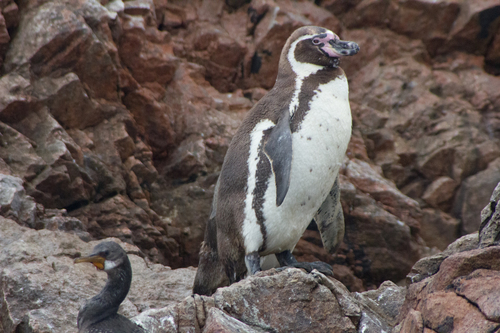
Humboldt Penguin
The Humboldt Penguin (*Spheniscus humboldti*) is a medium-sized penguin species native to South America. It is named after the cold Humboldt Current, which flows along the coasts of Peru and Chile, where this penguin resides. Known for their distinctive black and white plumage and bare, pink facial patches, Humboldt Penguins play a crucial role in their marine ecosystem as both predator and prey. They are an indicator species, meaning their population health reflects the overall health of the coastal environment. Culturally, they are iconic symbols of the region, often featured in local art and conservation campaigns.
65-70 cm
Length
Not applicable (wings modified into flippers) cm
Wingspan
Vulnerable
Conservation Status
Distribution
The Humboldt Penguin is found along the Pacific coast of South America, primarily in Peru and Chile. Its range extends from Isla Foca (northern Peru) to Algarrobo (central Chile). They breed on rocky coastlines and islands, often in areas with cliffs and caves.
Lifespan
Typically 15-20 years in the wild; up to 30 years in captivity.
Humboldt Penguin's Habitat
Habitat Types
Rocky coastlines, Islands, Coastal cliffs, Caves
Climate Zones
Arid, Temperate
Adaptations
Humboldt Penguins have several adaptations for their marine environment. These include dense, waterproof feathers for insulation; strong, flipper-like wings for swimming; and bare facial patches to help regulate body temperature in warmer periods. They also have salt glands to excrete excess salt from the seawater they ingest.
Variations
No recognized subspecies exist; however, slight variations in size and plumage characteristics have been observed between northern and southern populations.
Appearance
Breeding Plumage
Plumage remains largely consistent throughout the year. However, during molting (after breeding), feathers become duller and worn before being replaced.
Seasonal Feather Changes
Minimal seasonal variation beyond the molting period.
Sex Based Plumage Differences
Limited sexual dimorphism; males and females have similar plumage. Males may have slightly broader heads and bills.
Notable Features
Black head with a white border running from behind the eye to the chin., Pink, fleshy gape extending around the eye., Blackish-gray upperparts and white underparts., A black breast band extending down the flanks to the thigh.
Diet and Feeding
Primary Foods
Anchovies, Sardines, Squid, Crustaceans
Foraging Behavior
Humboldt Penguins are pursuit divers, using their powerful flippers to propel themselves underwater. They typically forage in groups, often close to shore, but can dive to depths of up to 60 meters. They hunt by sight, pursuing prey and capturing it with their beaks.
Specializations
Their streamlined bodies and powerful flippers allow for efficient underwater pursuit. Their eyes are adapted for underwater vision.
Seasonal Diet Variations
Diet varies depending on the availability of prey, which is influenced by oceanographic conditions such as El Niño, which can drastically reduce fish populations.
Behavior
Social Structure
Humboldt Penguins are highly social, forming large breeding colonies that can number in the thousands. Outside of breeding season, they may form smaller groups at sea.
Communication
Vocalizations, including braying calls (similar to a donkey's bray)., Visual displays, such as head-swinging and flipper-waving., Mutual preening.
Migration
Humboldt Penguins are not truly migratory in the long-distance sense, but they may disperse along the coast in search of food, following prey movements.
Territorial or Group Behaviors
They are territorial during breeding, defending their nest site from intruders. At sea, they often forage in groups, potentially cooperating to herd fish.
Conservation
Threats
Overfishing of prey species (especially anchovies)., Entanglement in fishing gear., Habitat destruction (guano extraction, coastal development)., Climate change and El Niño events (affecting prey availability)., Predation by introduced species (e.g., rats, cats) on eggs and chicks., Human disturbance at breeding colonies.
Protection Programs
Establishment of protected areas and marine reserves., Regulation of guano harvesting., Research and monitoring programs., Efforts to reduce bycatch in fisheries., Captive breeding programs in zoos and aquariums.
Local National Laws
Protected under national laws in both Peru and Chile. Listed in Appendix I of CITES (Convention on International Trade in Endangered Species), prohibiting international trade.
Population Trend
Decreasing
Population Estimates
Estimated at around 23,800 mature individuals (as of 2018 IUCN assessment).
Interesting Facts
They can hold their breath for over a minute.
This allows them to dive and pursue prey underwater effectively.
The pink skin around their eyes helps them regulate their temperature.
In hot weather, blood vessels in this area dilate, releasing heat.
They are named after the explorer Alexander von Humboldt.
The cold Humboldt Current, their primary habitat, is also named after him.
They can swim at speeds of up to 30 km/h (19 mph).
This is crucial for chasing down fast-moving prey like anchovies.
Faqs about Humboldt Penguin
Do Humboldt Penguins live in Antarctica?
No, Humboldt Penguins are found along the coast of Peru and Chile in South America, not in Antarctica.
What is the main threat to Humboldt Penguins?
The main threats are overfishing of their prey, entanglement in fishing gear, and habitat destruction.
How can I help Humboldt Penguins?
Support sustainable fisheries, reduce your consumption of seafood that impacts their prey, and support conservation organizations working to protect their habitat.
Are Humboldt Penguins friendly?
While they are not aggressive, they are wild animals and should be observed from a respectful distance. It's crucial not to disturb their nesting sites or approach them too closely.
Copyright @ Nature Style Limited. All Rights Reserved.
 English
English